Multimodal convergence within the intraparietal sulcus of the macaque monkey
- PMID: 23447621
- PMCID: PMC6619317
- DOI: 10.1523/JNEUROSCI.1421-12.2013
Multimodal convergence within the intraparietal sulcus of the macaque monkey
Abstract
The parietal cortex is highly multimodal and plays a key role in the processing of objects and actions in space, both in human and nonhuman primates. Despite the accumulated knowledge in both species, we lack the following: (1) a general description of the multisensory convergence in this cortical region to situate sparser lesion and electrophysiological recording studies; and (2) a way to compare and extrapolate monkey data to human results. Here, we use functional magnetic resonance imaging (fMRI) in the monkey to provide a bridge between human and monkey studies. We focus on the intraparietal sulcus (IPS) and specifically probe its involvement in the processing of visual, tactile, and auditory moving stimuli around and toward the face. We describe three major findings: (1) the visual and tactile modalities are strongly represented and activate mostly nonoverlapping sectors within the IPS. The visual domain occupies its posterior two-thirds and the tactile modality its anterior one-third. The auditory modality is much less represented, mostly on the medial IPS bank. (2) Processing of the movement component of sensory stimuli is specific to the fundus of the IPS and coincides with the anatomical definition of monkey ventral intraparietal area (VIP). (3) A cortical sector within VIP processes movement around and toward the face independently of the sensory modality. This amodal representation of movement may be a key component in the construction of peripersonal space. Overall, our observations highlight strong homologies between macaque and human VIP organization.
Figures

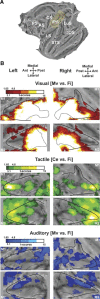
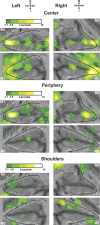
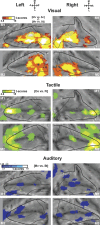
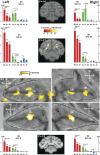
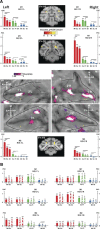

Similar articles
-
Mapping the parietal cortex of human and non-human primates.Neuropsychologia. 2006;44(13):2647-67. doi: 10.1016/j.neuropsychologia.2005.11.001. Epub 2005 Dec 12. Neuropsychologia. 2006. PMID: 16343560
-
Human medial intraparietal cortex subserves visuomotor coordinate transformation.Neuroimage. 2004 Dec;23(4):1494-506. doi: 10.1016/j.neuroimage.2004.08.031. Neuroimage. 2004. PMID: 15589113
-
Evidence for a Causal Contribution of Macaque Vestibular, But Not Intraparietal, Cortex to Heading Perception.J Neurosci. 2016 Mar 30;36(13):3789-98. doi: 10.1523/JNEUROSCI.2485-15.2016. J Neurosci. 2016. PMID: 27030763 Free PMC article.
-
The functional organization of the intraparietal sulcus in humans and monkeys.J Anat. 2005 Jul;207(1):3-17. doi: 10.1111/j.1469-7580.2005.00426.x. J Anat. 2005. PMID: 16011542 Free PMC article. Review.
-
Multisensory space: from eye-movements to self-motion.J Physiol. 2011 Feb 15;589(Pt 4):815-23. doi: 10.1113/jphysiol.2010.195537. Epub 2010 Oct 4. J Physiol. 2011. PMID: 20921203 Free PMC article. Review.
Cited by
-
Parietal maps of visual signals for bodily action planning.Brain Struct Funct. 2021 Dec;226(9):2967-2988. doi: 10.1007/s00429-021-02378-6. Epub 2021 Sep 10. Brain Struct Funct. 2021. PMID: 34508272 Free PMC article. Review.
-
Automatic multisensory integration follows subjective confidence rather than objective performance.Commun Psychol. 2025 Mar 11;3(1):38. doi: 10.1038/s44271-025-00221-w. Commun Psychol. 2025. PMID: 40069314 Free PMC article.
-
Tactile representation of the head and shoulders assessed by fMRI in the nonhuman primate.J Neurophysiol. 2016 Jan 1;115(1):80-91. doi: 10.1152/jn.00633.2015. Epub 2015 Oct 14. J Neurophysiol. 2016. PMID: 26467517 Free PMC article.
-
Receptor-driven, multimodal mapping of cortical areas in the macaque monkey intraparietal sulcus.Elife. 2020 Jul 2;9:e55979. doi: 10.7554/eLife.55979. Elife. 2020. PMID: 32613942 Free PMC article.
-
Connectome-scale functional intrinsic connectivity networks in macaques.Neuroscience. 2017 Nov 19;364:1-14. doi: 10.1016/j.neuroscience.2017.08.022. Epub 2017 Aug 24. Neuroscience. 2017. PMID: 28842187 Free PMC article.
References
-
- Akbarian S, Grüsser OJ, Guldin WO. Corticofugal connections between the cerebral cortex and brainstem vestibular nuclei in the macaque monkey. J Comp Neurol. 1994;339:421–437. - PubMed
-
- Andersen RA, Cui H. Intention, action planning, and decision making in parietal-frontal circuits. Neuron. 2009;63:568–583. - PubMed
-
- Avillac M, Denève S, Olivier E, Pouget A, Duhamel JR. Reference frames for representing visual and tactile locations in parietal cortex. Nat Neurosci. 2005;8:941–949. - PubMed
Publication types
MeSH terms
Substances
LinkOut - more resources
Full Text Sources
Other Literature Sources
